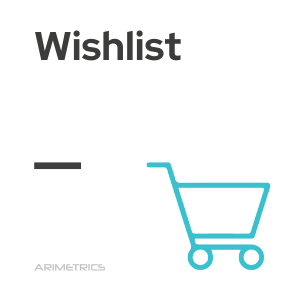
Definition:
A wishlist is a tool that allows customers to save and organize products of interest in one place. Its main function is to enable users to store items they find appealing, thus avoiding the need to search for them again in the future. This resource is widely used in digital marketing by online stores to enhance the user experience. It allows customers to express interest in a product without the pressure of an immediate purchase, which can increase engagement and customer satisfaction.
What is the wishlist for?
Wish lists bring strategic value to e-commerce. Customers are provided with a resource that allows them to “save” a product without having to commit to buying it. Navigation is much more comfortable, especially on mobile devices and this ends up being a stimulus to generate more sales.
How to use the wish list?
Wish lists provide a lot of valuable data. Thanks to them, you can identify patterns and carry out marketing strategies to generate more sales.
- Remarketing lists: Wish lists are an exceptional source of users to create retargeting lists. Thanks to the information given by the user, they can be impacted through advertising to get the purchase process finished.
- Viralize:The wish list that you can share promote brand awareness and serve to promote products. Users who have added products to their wish list share it with other users, generating potential customers.
- Out-of-stockproducts: when an ecommerce runs out of stock, wish lists allow users to track the status of the item. Customers who saved the product out of stock on their wish list will be notified when there is again availability to purchase it.
- Discount alert:once the products that interest the user are known, marketing strategies can be carried out to encourage them to finish the purchase. The customer may be advised that the product on the list has an offer or that there is little stock left.
Advantages of wishlist
- Generate leads: wish lists are a middle ground between purchase and oblivion. And it is that in general, buyers are not always ready to end up making the payment, but they do want to remember or have on hand the product that once interested them.
Registered users: with the wish list it is possible for the user to register, something that will increase the ecommerce database based on potential customers. - They improve User Experience: when you enter an ecommerce and the user adds products to the cart but does not end up buying and leaves the page, those items that interested him lose them and have to return to them. The wish list generates a much friendlier, more agile and faster UX for the user, thus increasing the purchase intention.
- Improve conversion rate: Increase the probability that a visit ends up as a customer.
- Recurring customers: Helps build customer loyalty.
- Less cart abandonment: They reduce the percentage of cart abandonment, avoiding added products to buy later.
Wishlists Examples
Here are some examples of sites that use wishlists:
- Amazon: One of the largest e-commerce platforms in the world and offers a wishlist feature that allows users to save products they’re interested in for later purchase.
- Etsy: An online platform for buying and selling handmade and vintage products. It offers a wishlist feature that allows users to save products they are interested in for later purchase.
- eBay: It is an online auction platform that also offers a wish list feature that allows users to save products they are interested in for later purchase.
- Zara: A clothing and accessories brand that has an online store and offers a wishlist feature that allows users to save products they are interested in to buy later.
- Sephora: A beauty and personal care brand that has an online store and offers a wishlist feature that allows users to save products they are interested in for later purchase.
